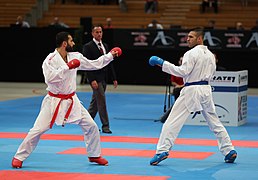Kumite
Kumité (Japanese: 組手) literally means "clasping the hands" or "combat" in Japanese and, together with kata and kihon, constitutes a fundamental element within the practice of karate.
Explanation
Kumite is a combat in which some of the techniques practiced in kihon or kata are applied in a confrontation with a real opponent.
Correctness and thoroughness in the execution of techniques and tactics are essential in kumite, bringing into play both the physical and mental ability of the competitors. This task is not easy, especially for beginners, and only after some time can practitioners acquire the concentration and mastery of their body necessary to execute each technique with appropriate effectiveness and strength.
Types of kumite
Kumite receives different names depending on the focus of its practice:
- Kihon kumite: consists of the application of attacks on a partner and defenses against attacks of this. The attacks and defences to be carried out are set in advance and emphasis is placed on the technical aspect of the exercise. Depending on the number of techniques, the ippon kumite (a defense and counterattack) and the sanbon kumite (three defenses and counterattack) are common.
- Shiai kumite: consists of a regulated combat involving an arbitrator and several judges. Attacks that according to established criteria would have been effective in a real confrontation are punctuated. However, hurting or hitting in certain areas the opponent carries, not only the annulment of the technique, but also a criminalization. The score at the end of the meeting determines a winner.
- Jyu kumite: consists of the free application of attack and defense techniques without having previously established what these techniques will be. It can be "deportive" style, freely practising the applications of techniques for sports kumite, or it is also called Jyu Kumite to practice -in some karate schools - of realistic but harmless combat of karate techniques in a situation of personal defense against an aggression without rules.
In most traditional karate styles such as Shorin Ryu, Shotokan, Shito Ryu, Wado Ryu, Goju Ryu, etc. Kumite is performed within categories by weight and to the point, with a regulation of permitted surfaces (what is hit) and contact areas (where it is hit). In Kyokushinkai style karate the kumite is free and with full contact, with the exception of the blow with the fist to the face. Although it has judges and rules, this type of combat is not based on points and seeks the opponent's loss of consciousness or knock out.
Scheme of competitions according to the WKF (World Karate Federation / World Karate Federation) or sports karate to the point

In the WKF-type competition scheme, kumite is performed by points, giving greater importance to kicks than to punches. The fight takes place in a delimited area that must not be crossed by any competitor, since, if a participant steps outside of this, it is considered jogai (a category 2 foul). Points were generally distributed as follows until 2004:
- 1 pto(wazari): tsuki / fist to chudan / mid zone.
- 2 ptos (ippon): Tsuki / cuff to yodan or high area.
The points used to be generally distributed as follows since the year 2022:
- 1 st (Yuko(c): Punch beatings to medium zone chudan o, to high area Yodan.
- 2 ptos (Wasari(c): chudanor a tsuki / fist on the back.
- 3 ptos (Ippon(): Patada Yodan (head), or when a sweep was running plus one tsuki /pun while the opponent is on the floor.
But after the reform of the WKF in the 2008/2009 season, they are considered as follows:
- 1 st (Yuko): Puncture beatings chudan or Yodan.
- 2 ptos (Wasari): High-level kicks chudan.
- 3 ptos (Ippon): High-level kicks Yodanor hit the rival when he is on the ground, having a maximum of 2 seconds to do so.
Currently, in the latest reform of the regulations of the World Karate Federation, it is stipulated:
- 1 pto(Yuko): Chudan or Jodan Tsuki and Jodan or chudan Uchi.
- 2 ptos (Waza-ari): Kicks to Chudan.
- 3 ptos (Ippon): Kicked to yodan or any punctuable technique performed on a fallen opponent.
In sporting combats you obtain a certain sporting advantage Seinsho, which is obtained by making the first point. In sports competitions, blows below the waist are prohibited, as well as the use of elbows and knees, or any other open hand technique that judges consider dangerous or unsportsmanlike. The use of a prohibited technique entails a warning and then (or even directly) reprimands. As these are repeated, the opponent is the one who receives the points. Three category 1 warnings imply elimination for hansoku.
Other scoring schemes
The techniques accepted for a competition must be limited to only some areas to be valid:
- Head
- Cara
- Neck.
- Abdomen
- Pecho
- Rear area
- Side area (sides)
In addition, in the latest version of the WKF competition regulations, it is indicated that for a technique to be scored it must have ALL those defined within the same document such as:
- Good shape.
- Sporting attitude
- Vigorous application
- Zanshin
- Good Timing
- Correct distance
Contenido relacionado
Annex: Fencing at the Atlanta 1996 Olympic Games
Annex: Athletics at the Sydney 2000 Olympic Games
Eurocup